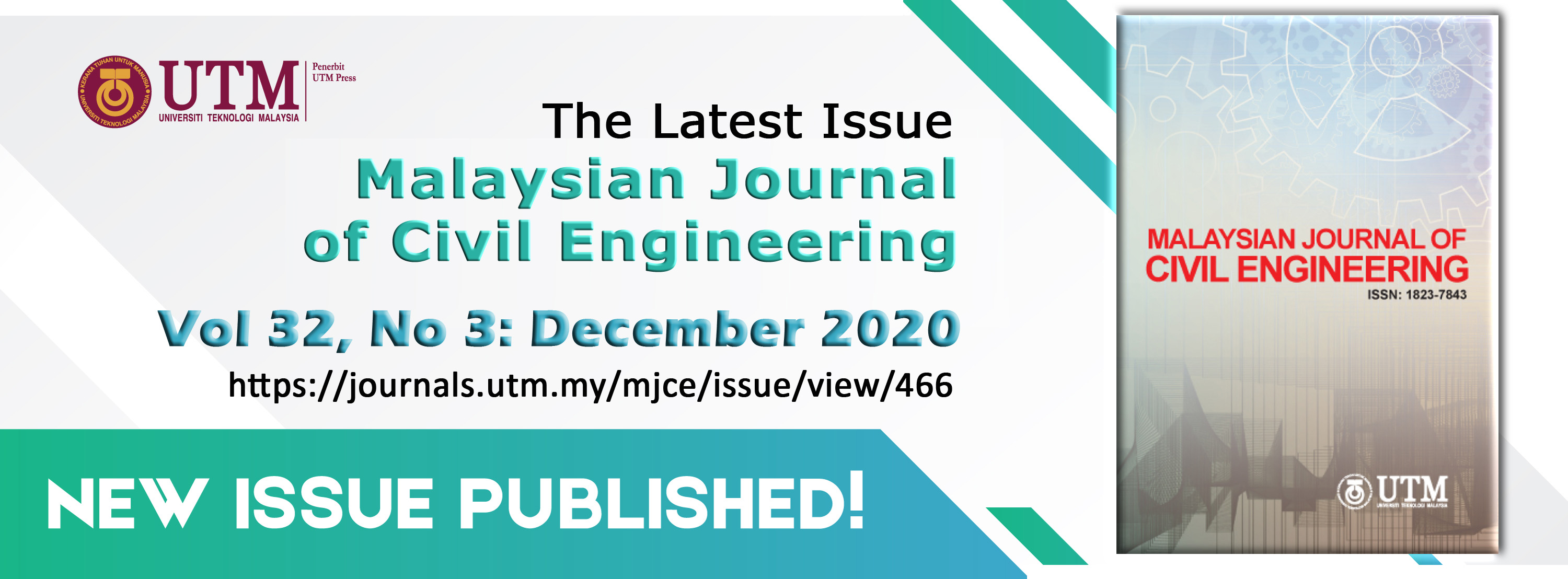CORRELATION BETWEEN INTENSITY MEASURE PARAMETERS OF GROUND MOTION EARTHQUAKES AND STRUCTURAL RESPONSE OF MOMENT RESISTING STEEL FRAMES
DOI:
https://doi.org/10.11113/mjce.v32.16206Keywords:
Intensity measure parameters, seismic response of structures, Near-source, Far-source, nonlinear time history analysisAbstract
Identify and select a suitable ground motion intensity measure (IMs) parameters associated with the structural response to specific levels of damages or collapse in structures are very important in the seismic response of structural analyses. This paper investigated the correlation between 25 intensity measure (IMs) parameters of earthquakes and the structural response parameters of 3-, 6- and 12-story moment resisting steel frames (MRSFs). Nonlinear time history analyses are performed for these frames under near- and far-source ground motion records. The maximum story drift ratio (MSDR), the roof drift ratio (RDR), and the maximum base shear force (SF) are chosen as the structural response parameters. The Pearson correlation coefficient with the regression analyses is utilized to display the correlation between the structural response parameter and the ground motion IMs parameters. The results reveal that MSDR appears to be a suitable engineering demand parameter to correlate with most of the ground motion IMs parameters compared to both the RDR and the SF parameters. Also, Max. Incremental velocity (MIV) parameter is considered as the highest correlated IMs parameters with MSDR in both near- and far-source earthquakes.
References
Anderson, J.C., and Bertero, V.V. (1987). Uncertainties in Establishing Design Earthquakes. Journal of Structural Engineering 113, pp. 1709.
Ang, A.H.S., and Tang, W.H. (2007). Probability Concepts in Engineering: Emphasis on Applications in Civil & Environmental Engineering, vol. 1, Wiley and Sons.
Arias, A. (1970) A measure of earthquake intensity, in Seismic Design for Nuclear Power Plants. R.J. Hansen (Editor), MIT Press, Cambridge, Massachusetts, 438–483.
ASTM. (1985). Cycle counting in fatigue analysis, Annual Book of ASTM Standards. Vol. 03.01, Designation E1049-85.
Bianchini, M., Diotallevi, P., and Baker, J.W. (2009). Prediction of Inelastic Structural Response Using an Average of Spectral Accelerations. 10th International Conference on Structural Safety and Reliability (ICOSSAR09), Osaka, Japan.
Dobry, R., Idriss, I.M., NgE. (1978). Duration characteristics of horizontal components of strong motion earthquake records. Bull Seismol. Soc, Am. 68:1487–520.
ECP-201. (2012). Egyptian Code for Calculating Loads and Forces in Structural Work and Masonry. Housing and Building National Research Center, Ministry of Housing, Utilities and Urban Planning, Cairo, Egypt.
ECP-205. (2008). Egyptian Code for Practice for Steel Construction (LRFD). Research Center for Housing and Building, Giza, Egypt.
Electrical Power Research Institute (EPRI). (1988). A criterion for determining exceedance of the operating basis earthquake. Report No. EPRI NP-5930, Palo Alto, CA.
FEMA P695. (2009). Quantification of building seismic performance factors. FEMA, Prepared by the Applied Technology Council for the Federal Emergency Management Agency, Washington, D.C.
Guaman, J.W. (2010). Empirical Ground Motion Relationship for Maximum Incremental Velocity. Master's Thesis, University of Notre Dame.
Hancock, J., Bommer, J.J., and Stafford, P.J. (2008). Numbers of scaled and matched Accelerograms required for inelastic dynamic analyses. Earthquake Engineering and Structural Dynamics 37: 1585-1607.
Habibi, A., and Jami, E. (2016). Correlation between Ground Motion Parameters and Target Displacement of Steel Structures. International Journal of Civil Engineering 15: 163–174.
Housner, G.W. (1952). Spectrum Intensities of Strong-Motion Earthquakes. In: Proceedings of the Symposium on Earthquake and Blast Effects on Structures: Los Angeles. California, Earthquake Engineering Research Institute, Los Angeles, pp: 20-36.
Jayaram, N., Mollaioli, F., Bazzurro, P., De Sortis, A., and Bruno, S. (2010). Prediction of structural response of reinforced concrete frames subjected to earthquake ground motions. 9th U.S. National and 10th Canadian Conference on Earthquake Engineering, pp: 428-437, 25-29 July, Toronto, Canada.
Kenari, M.S., and Celikag, M. (2019). Correlation of Ground Motion Intensity Measures and Seismic Damage Indices of Masonry-Infilled Steel Frames. Arabian Journal for Science and Engineering 44: 5131–5150.
Kramer, S.L. (1996). Geotechnical earthquake engineering. NewJersy: Prentice Hall.
Makris, N., and Black, J.C. (2004). Evaluation of Peak Ground Velocity as a "Good" Intensity Measure for Near Source Ground Motions. Journal of Engineering Mechanics 130: 1032-1044.
Malhotra, P.K. (2002). Cyclic-demand spectrum. Earthquake Engineering and Structural Dynamics 31: 1441–1457.
Miranda, E. (1993). Evaluation of site-dependent inelastic seismic design spectra. J. Struct. Eng. 119: 1319–1339.
Naumoski, N., Tso, W.K., and Heidebrecht, A.C. (1988). A selection of Representative Strong Ground Motion Earthquake Records Having Different A/V Ratios. Report No. EERG 88/01, Earthquake Engineering Research Group, McMaster University, Hamilton, Ontario.
Nuttli, O.W. (1979). The relation of sustained maximum ground acceleration and velocity to earthquake intensity and magnitude. Miscellaneous Paper S-71-1, Report 16, U.S. Army Corps of Engineers, Waterways Experiment Station, Vicksburg, Mississippi.
Perrault, M., and Guéguen, P. (2015). Correlation between Ground Motion and Building Response Using California Earthquake Records. Earthquake Spectra 31: 2027-2046.
Prakash, V., and Powell, G.H. (1992). DRAIN-2DX user guide. Department of Civil Engineering, University of California, Berkeley, California.
Panella, D.S., Tornello, M.E., and Frau, C. (2017). A simple and intuitive procedure to identify pulse-like ground motions. Soil Dynamics and Earthquake Engineering 94: 234-243.
Rathje, E.M., Abrahamson, N.A., and Bray, J.D. (1998). Simplified frequency content estimates of earthquake ground motions. Journal of Geotechnical and Geoenvironmental Engineering 124: 150-159.
Riddell, R. (2007). On ground motion intensity indices. Earthquake Spectra 23: 147-173.
Sarma, S.K., and Yang, K.S. (1987). An evaluation of strong motion records and a new parameter A95. Earthquake Engineering & Structural Dynamics, 15: 119 – 132. DOI: 10.1002/eqe.4290150109.
Seismo Signal, (2018). Pavia, Italy: Seism soft Ltd. Retrieved from http://www.seismosoft.com/en/HomePage.aspx
Von, Thun J.L., Rochim, L.H., Scott, G.A., Wilson, J.A. (1988). Earthquake ground motions for design and analysis of dams. Earthquake Engineering and Soil Dynamics II - Recent Advances in Ground-Motion Evaluation", Geotechnical Special Publication 20: 463-481.
Yang, D., Pan, J., Li, G. (2009). Non-structure-specific intensity measure parameters and characteristic period of near-fault ground motions. Earthq. Eng. Struct. Dyn. 38: 1257–1280.
















